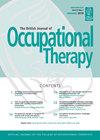利用时间日记为肌痛性脑脊髓炎/慢性疲劳综合征患者提供职业治疗实践信息:探索性研究
IF 1.3
4区 医学
Q3 REHABILITATION
引用次数: 0
摘要
肌痛性脑脊髓炎/慢性疲劳综合症会影响个人的职业参与。澳大利亚对肌痛性脑脊髓炎/慢性疲劳综合征的职业干预了解甚少。本研究探讨了患有肌痛性脑脊髓炎/慢性疲劳综合征的澳大利亚成年人如何利用自己的时间,以及国家健康研究所的活动记录能否为职业干预提供信息。九名参与者采用聚合混合方法,完成了国家健康研究所活动记录时间日记和五个调查问题,探讨了临床实用性和肌痛性脑脊髓炎/慢性疲劳综合征的影响。数据分析包括时间使用数据的描述性统计和调查回答的归纳主题分析。据参与者(29-59 岁)报告,他们 58% 的时间用于清醒状态下的娱乐和休闲活动。定量数据显示,参与者全天的症状、表现和动力在统计上没有显著变化。定性数据中出现了六个主题,强调了参与者填写国家健康研究所活动记录的经历以及肌痛性脑脊髓炎/慢性疲劳综合征对其时间使用的影响。国家健康研究所活动记录 "有助于了解参与者的时间使用情况,从而为职业干预提供依据。修改国家健康研究所活动记录格式将提高参与者的可用性并缩短完成时间。讨论结果和延长数据收集期可以更准确地捕捉到肌痛性脑脊髓炎/慢性疲劳综合征的影响和波动。本文章由计算机程序翻译,如有差异,请以英文原文为准。
Using time diaries to inform occupational therapy practice for people with Myalgic Encephalomyelitis/Chronic Fatigue Syndrome: An exploratory study
Myalgic encephalomyelitis/chronic fatigue syndrome affects an individual’s occupational participation. There is little understanding in Australia of occupational interventions for myalgic encephalomyelitis/chronic fatigue syndrome. This study explored how Australian adults with myalgic encephalomyelitis/chronic fatigue syndrome use their time and whether the National Institute of Health Activity Record can inform occupational interventions. Using a convergent mixed method, nine participants completed the National Institute of Health Activity Record time diary and five survey questions exploring clinical utility and the impact of myalgic encephalomyelitis/chronic fatigue syndrome. Data analysis included descriptive statistics for time-use data and an inductive thematic analysis for survey responses. Participants (aged 29–59 years) reported 58% of their time was spent awake and in recreation and leisure occupations. Quantitative data reflected no statistically significant change in participants’ symptoms, performance and motivation throughout the day. Six themes emerged from the qualitative data that highlighted participants’ experiences completing the National Institute of Health Activity Record and the impact of myalgic encephalomyelitis/chronic fatigue syndrome on their time-use. The National Institute of Health Activity Record provided insights into a participant’s time-use, which could inform occupational interventions. Modifying the National Institute of Health Activity Record format would improve usability for participants and reduce time for completion. Discussing results and extending the data collection period may capture the impact and fluctuations of myalgic encephalomyelitis/chronic fatigue syndrome more accurately.
求助全文
通过发布文献求助,成功后即可免费获取论文全文。
去求助
来源期刊

British Journal of Occupational Therapy
REHABILITATION-
CiteScore
2.20
自引率
15.40%
发文量
81
审稿时长
6-12 weeks
期刊介绍:
British Journal of Occupational Therapy (BJOT) is the official journal of the Royal College of Occupational Therapists. Its purpose is to publish articles with international relevance that advance knowledge in research, practice, education, and management in occupational therapy. It is a monthly peer reviewed publication that disseminates evidence on the effectiveness, benefit, and value of occupational therapy so that occupational therapists, service users, and key stakeholders can make informed decisions. BJOT publishes research articles, reviews, practice analyses, opinion pieces, editorials, letters to the editor and book reviews. It also regularly publishes special issues on topics relevant to occupational therapy.
 求助内容:
求助内容: 应助结果提醒方式:
应助结果提醒方式:


